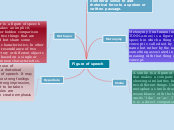Figure of speech
a word or phrase used in a nonliteral sense to add rhetorical force to a spoken or written passage.
Metonymy
Metonymy (/mᵻˈtɒnᵻmi/ mi-TONN-ə-mee) is a figure of speech in which a thing or concept is called not by its own name but rather by the name of something associated in meaning with that thing or concept.
The typical teenage boy’s room is a disaster area.
He writes with a fine hand.-means he has a good handwriting.
The House was called to order.- refers to the members of the House.
Simile
A simile is a figure of speech that makes a comparison, showing similarities between two different things. Unlike a metaphor, a simile draws resemblance with the help of the words “like” or “as”. Therefore, it is a direct comparison.
My love is like a red, red rose.
You were as brave as a lion.
They fought like cats and dogs.
Methapor
Metaphor is a figure of speech which makes an implicit, implied or hidden comparison between two things that are unrelated but share some common characteristics. In other words, a resemblance of two contradictory or different objects is made based on a single or some common characteristics.
The detective listened to her tales with a wooden face.
She was fairly certain that life was a fashion show.
The typical teenage boy’s room is a disaster area.
Hyperbole
Hyperbole is the use of exaggeration as a rhetorical device or figure of speech. It may be used to evoke strong feelings or to create a strong impression, but is not meant to be taken literally. Hyperboles are exaggerations to create emphasis or effect.
The House was called to order.- refers to the members of the House.
I have a million things to do.
I had to walk 15 miles to school in the snow, uphill.
